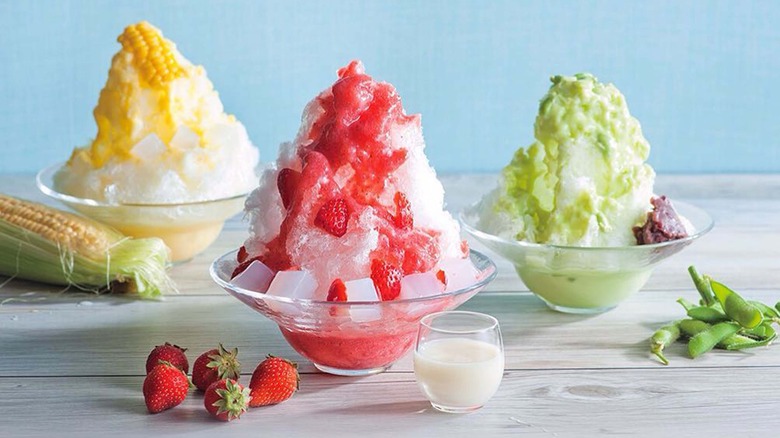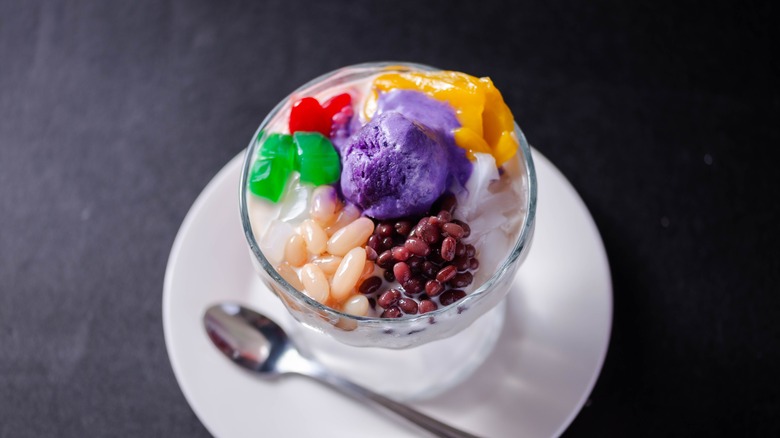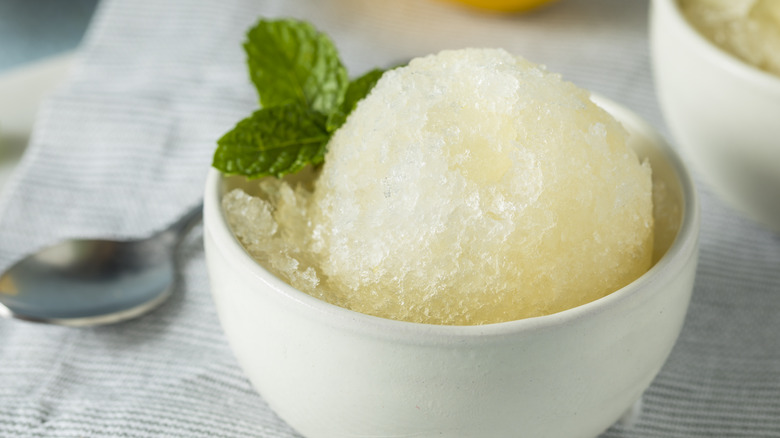What's The Difference Between Italian Ice And Shaved Ice?
In some cities, the opening of the Italian-ice stand is a harbinger of summer. On a sweltering day, nothing hits quite like this frozen treat, made of little more than water, sugar, and fruit — often lemon, though not always — and scooped into a cup for serving. Since its debut in New Jersey over a century ago, Italian ice has gained legions of followers in cities like Chicago — where it's sometimes called Italian lemonade — and Philadelphia, where a regional variation is known as water ice.
No matter what you call it, though, don't call it shaved ice. One difference? Well, it's not shaved. Shaved ice commonly begins with the ingredient in its name — frozen water — that's crushed or shaved, then flavored to ordered with syrup. More sorbet than slushie, Italian ice is fully mixed before freezing, like ice cream — and owes its finer texture to the fact that it's churned in an ice cream machine.
Still, as a water-based frozen treat, Italian ice is definitely a relative of shaved ice — and, therefore, of the whole family of delicious shaved-ice desserts. Before drilling down on Italian ice, let's stop to wonder at this sweet, frosty world — and we do mean "world," as cultures around the globe have originated their own spins on this basic template. From Japanese kakigori to Korean bingsu to New Orleans sno-balls, shaved ice has got fans in every corner of the planet.
An introduction to the world of shaved ice
Shaved ice is especially big in Southeast Asia. In Korea, for instance, you might encounter it as bingsu; milk-based rather than water-based, bingsu is served as a pillowy mountain of soft shavings topped with sweetened condensed milk, fresh fruit, sweetened red beans, and other goodies. Japan's shaved ice, called kakigori, dates back a millennium or so. Originally, scrapings were taken from huge blocks of ice before being doused in syrup. This was something that, before the advent of refrigeration, was generally enjoyed only by the wealthy.
As technology developed and people moved around the world, so did kakigori. It made its way to Hawaii, where finely shaved ice is sprinkled with fruit syrup and often served with ice cream, mochi, red beans, and more. Kakigori also inspired the colorful Filipino dessert halo-halo, featuring a riot of texturally captivating add-ins, from tapioca pearls to cubes of flan to ice cream made from the purple yam known as ube.
In recent years, halo-halo has attracted a lot of devotees in the U.S. — one of the scores of global shaved-ice desserts you can get here today, including Mexican raspados. The U.S., meanwhile, has a couple of homegrown shaved-ice traditions of its own, like the state-fair snow cone and the beloved New Orleans-style sno-ball. What unites all of the above? They're plain ice, shaved coarse or fine, and flavored to order. They're not, in other words, Italian ice.
Where does Italian ice come from?
Italian ice might be associated with summer, but it hails from a chilly place: Mount Etna, where the Sicilians who lived downslope collected snow to use it for refrigeration and refreshment. They put it in wine, for instance (today — FYI — it is not always safe to eat snow). Tenth century Arab migration brought both citrus and sugar ... maybe you're beginning to see where this is going. We don't know exactly the circumstances surrounding the birth of sorbets and granitas — the forerunners of Italian ice. But we do know that by the 16th century, Sicilians had discovered the principle that also made the old hand-crank ice cream machines possible: You don't need artificial refrigeration, just ice and salt, to make a delectable frozen treat. Thus were the ingredients and technologies in place for the eventual creation of Italian ice.
Granitas are what an Italian immigrant and grocer named Caterina Di Cosmo was thinking about in 1915 in New Jersey, when she froze a mixture of water, lemon, and sugar, eventually selling the results as "Italian ice." Still in business today, DiCosmo's has been joined by scores of other shops around the country. Lemon remains the classic flavor, but it's not the only one: Mario's Italian Lemonade, one of Chicago's most popular spots, boasts blue raspberry, strawberry, watermelon, and more, and Rita's Ice — a Pennsylvania standby — even has flavors like Swedish Fish.


